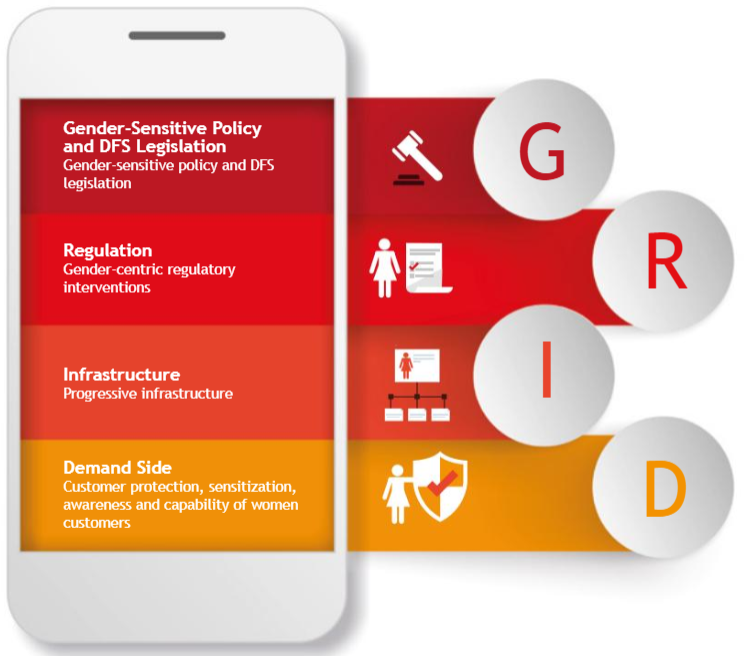6 July 2020
Empowering women via the G.R.I.D. Framework
By Helen Walbey, AFI Head Gender Inclusive Finance & Adeyemi Omotoso, Policy Specialist, FInTech, AFI
The financial inclusion gender gap of nine percent stubbornly persists in developing countries and nearly a billion women, globally, remain financially excluded. Ongoing barriers that led to this range from socio-cultural factors, lack of gender sensitive policies, limited ownership of mobile technology, as well as access to digital devices and related capability to use them.
As a cross cutting thematic area, the women’s financial inclusion agenda has been of great interest in all AFI working groups. With the aim of studying factors that influence DFS adoption by women across different jurisdictions, the Digital Financial Services Working Group (DFSWG) set up a Gender sub-group chaired by Clarissa Kudowor from the Bank of Ghana.After extensive research into learnings, good practices and successful interventions from various country experiences within the AFI network and beyond, we have formulated the G.R.I.D. framework to support development of more gender inclusive policies and regulations with regards to DFS. With the Denarau Action Plan (DAP) target of the end of 2021 approaching quickly, this is a step in the right direction for members to fulfil their commitments and move closer towards halving their financial inclusion gender gap.

Gender: Sensitive DFS Policies
Evidence across some countries shows that digitized government-to-person payments (G2P) are an attractive use case for the local population and can be the first step toward women’s full financial inclusion.
In Malaysia, approximately 99 percent of the federal government’s payments, such as salaries and pension payments, are made using e-payments. E-payments are also used to facilitate efficient distribution of social benefits such as MyKasih, a nationwide food-aid distribution supported by several government agencies, where the Government issued identification cards are used to facilitate the distribution of basic necessities to the poor
With the aim of fostering greater economic empowerment of women, the Central Bank of Egypt and Bank of Ghana also implemented digitalization of their Village Savings and Loans Association (VSLA) programs and their subsequent linkages to banks and mobile money wallets.
Regulation: Gender-centric regulatory interventions
Regulators, acting as catalysts, can support DFS ecosystem actors and stakeholders in addressing operational challenges through applying a gender lens when looking at the provision of appropriate and reliable access points for the distribution of DFS, such as cash-in/cash-out (CICO) agents and merchant payment points. Regulatory interventions should also encourage more diversity in the workforce of financial service providers to reflect the religious, social and cultural realities of their jurisdictions.
In India, the Agent Network Assessment (ANA) study provided evidence that women agents are equally or more, enterprising than men, with almost equal profit levels and a wider range of available services.
Infrastructure: Access to Technology, Payment Systems & Identity
The development of and access to retail payments, information, communication, and technology infrastructure such as switching, national automated clearing houses, telephony and internet services, that facilitate access to and use of DFS is an important feature of this framework. Policies or interventions promoting simplified/tiered know-your-customer (KYC) processes, e-KYC and customer due diligence (CDD) principles can facilitate and encourage the enrolment of women into market-wide identity systems to ensure women’s access to proof of identity.
Several financial regulators including the Bank of Zambia, Bank of Ghana, Bangko Sentral ng Pilipinas and Central Bank of Nigeria have developed and implemented initiatives such as national financial and payment switching platforms to interconnect all banks, mobile money operators and other financial service providers in an interoperable electronic payment system.
The Central Bank of Egypt (CBE) has asked startups in the country to present how they would set up and use e-KYC. A selection of start-ups will then be allowed to test their ideas under a regulatory sandbox, following which the CBE will likely amend existing regulations.
Demand Side: Customer protection, sensitization, awareness and capability of women customers
As women have a lower opportunity to gain high levels of financial literacy, there is a need for national strategies for financial literacy and education with special focus on evidence-based digital financial literacy and capability interventions. These interventions should be supported by strong and efficient consumer protection and grievance redress mechanisms to help generate trust and reduce risk and vulnerability among women customers.
The Bank of Ghana realized how different aspects of financial inclusion have to be tailored specifically for men and women. The Central Bank found that compared to women, men were more knowledgeable and confident when addressing their grievances through designated channels (in case of a mobile money product). Regulators at the Central Bank are now considering taking inputs from the Ministry of Women for their forthcoming initiatives to ensure they better cater for women.
The Path Forward for Gender-Sensitive DFS
While the COVID-19 pandemic is pushing the world towards greater use of DFS, we observe how it also reflects a turning point in women’s financial inclusion. On one hand, DFS is widely considered as a key leveler in closing the global gender gap where it comes to availability, access and usage of financial services. On the other hand, women not only lack the opportunity to access the technology, but also the financial literacy to use it.
In order to address these issues from a regulatory perspective, our Denarau Action Plan (DAP) has identified ten key areas where regulators and policy makers can take action to close the gender gap. Recognizing the key role that digital financial services (DFS) and innovative technologies plays in women’s financial inclusion a commitment to leverage on this has been incorporated as part of the DAP.
AFI has put together more best practices and proven interventions in addressing and increasing women’s financial inclusion in our latest publications, Policy Framework For Women’s Financial Inclusion Using Digital Financial Services and Lessons on Enhancing Women’s Financial Including Using Digital Financial Services.
*
The Gender Inclusive Finance workstream is partially financed by the Swedish International Development Cooperation Agency (Sida) and other partners.
© Alliance for Financial Inclusion 2009-2024